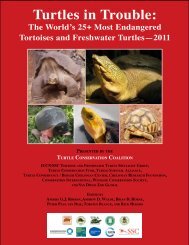WCS Annual Report 2012 - Wildlife Conservation Society
WCS Annual Report 2012 - Wildlife Conservation Society
WCS Annual Report 2012 - Wildlife Conservation Society
You also want an ePaper? Increase the reach of your titles
YUMPU automatically turns print PDFs into web optimized ePapers that Google loves.
wcs story<br />
harnessing the power of our zoos/aquarium<br />
and field conservation<br />
/<br />
1<br />
IN <strong>2012</strong>, WE CONTINUED TO USE OUR ZOO- AND AQUARIUM-BASED HUSBANDRY EXPERTISE TO<br />
PROTECT A VARIETY OF SPECIES, FROM INDONESIA’S RARE MALEO BIRD TO TANZANIA’S KIHANSI<br />
SPRAY TOAD — RETURNED TO ITS FORMER HABITAT AFTER GOING EXTINCT IN THE WILD. IN<br />
MOZAMBIQUE WE WORKED TO ESTABLISH A NEW RESERVE TO ADDRESS THE ONGOING CRISIS OF<br />
ELEPHANT POACHING, WHILE IN ARcTIC ALASKA OUR DATA HELPED TO STRIKE THE RIGHT BALANCE<br />
BETWEEN WILDLIFE PROTECTION AND ENERGY DEVELOPMENT. THESE AND OTHER STORIES DOCU-<br />
MENTED HERE CAPTURE AN ORGANIZATION EVER STRIVING TO FULFILL ITS MISSION TO PROTECT<br />
WILDLIFE AND WILD PLACES.<br />
Combining Zoo and Field Expertise to<br />
Save Species<br />
The reintroduction of some 2,000 spray toads to Tanzania’s Kihansi<br />
Gorge marked a major milestone for this tiny species. The repatriation<br />
effort was the result of a 12-year partnership between <strong>WCS</strong>’s Bronx<br />
Zoo, the Toledo Zoo, the government of Tanzania, and the World<br />
Bank after the toads’ misty habitat adjacent to a waterfall was<br />
disrupted by the construction of a new hydroelectric dam. The<br />
toads were bred at the Bronx and Toledo Zoos while their habitat was<br />
restored with an artificial misting system. In October, representatives<br />
of organizations partnering in the Kihansi project gathered with local<br />
village members to release the toads back into their native landscape.<br />
The exact time for this historical event: 2 P.M., October 30, <strong>2012</strong>.<br />
Three maleo chicks hatched at the Bronx Zoo after a roughly<br />
two-month-long incubation period. Adult maleos can be seen in<br />
the zoo’s World of Birds – the only place these unusual birds can<br />
be found outside of their native home of Sulawesi, an island in<br />
Indonesia. Maleos are members of the megapode family, almost<br />
half of whose species are threatened with extinction. Maleo<br />
numbers in the wild have declined drastically due to human egg<br />
collection and predation by invasive species. Knowledge gained<br />
at the Bronx Zoo regarding maleo incubation and chick survival<br />
has been used by <strong>WCS</strong> field staff in Sulawesi to hatch and head<br />
start chicks before returning them to the wild.<br />
<strong>WCS</strong>’s work to produce pure bison calves resulted from a<br />
recognition that the vast majority of present-day bison have traces<br />
of domestic cattle genes. The genes entered bison populations early<br />
in the 1900s as a result of interbreeding efforts when western<br />
ranchers tried to create a hardier breed of cattle. Unfortunately,<br />
the interbreeding resulted in bison that lack some of the very<br />
qualities that helped the species to survive for thousands of years<br />
in the harsh climate of North America’s Western prairies. In the<br />
fall of 2011, <strong>WCS</strong> arranged for a group of female bison to be implanted<br />
with genetically pure bison embryos. The result was the<br />
first-ever genetically pure bison calf produced by embryo transfer.<br />
Saving the World’s Most Endangered Turtles<br />
and Tortoises<br />
In <strong>2012</strong>, <strong>WCS</strong> announced a new strategy to take direct responsibility<br />
for the continued survival of some of the world’s most endangered<br />
tortoises and freshwater turtles. <strong>WCS</strong> will breed several species<br />
in captivity with the goal of returning them to the wild. <strong>WCS</strong><br />
captive collections will further serve as assurance colonies in the<br />
event that populations in the wild go extinct. Such colonies are<br />
designed to preserve the genetic variation of wild populations.<br />
More than half of the world’s approximately 330 species of<br />
freshwater turtles and tortoises are threatened with extinction<br />
due to both legal and illegal exploitation, as well as habitat loss.<br />
11<br />
wcs story







![RaLand / SeaScape [PDF] - Wildlife Conservation Society](https://img.yumpu.com/49974326/1/190x245/raland-seascape-pdf-wildlife-conservation-society.jpg?quality=85)









